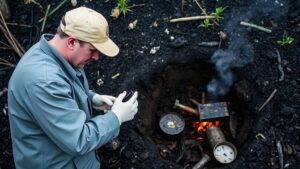Unearthing Arrowhead Caches in Known Battle Sites of Early Tribes
Unearthing Arrowhead Caches in Known Battle Sites of Early Tribes
The study of ancient arrowhead caches provides crucial insights into the warfare practices of early tribes. Archeologists and historians alike have long sought to understand the significance of these artifacts, especially in the context of known battle sites. This article will explore the various aspects of unearthing arrowhead caches, including methods of discovery, cultural implications, and notable case studies from various regions across North America.
Historical Context of Arrowheads in Tribal Warfare
Arrowheads, or projectile points, were pivotal in the hunting and warfare practices of early tribes. e tools not only served as lethal weapons but also reflected the technological competencies and material culture of their creators. Different tribes developed unique styles and types of arrowheads, such as the Flint Clovis points, which date back over 13,000 years, and the Apache points characterized by a distinct notching technique.
Understanding the materials used for crafting these arrowheads offers valuable context. For example, tribes often utilized locally available materials like flint, quartz, and obsidian. Studies suggest that the choice of material was influenced not only by availability but also by the material’s particular physical properties, such as hardness and ease of flaking. This differentiation offers clues about the region and the specific purposes for which the arrowheads were made.
Methods of Discovery
The discovery of arrowhead caches often occurs at archaeological digs, particularly in known battle sites where increased activity is expected. Modern techniques employed in this context include:
- SURFACE SURVEY: Archeologists often conduct systematic surface surveys of battle sites, meticulously recording the locations of visible artifacts.
- GROUND-PENETRATING RADAR (GPR): This non-invasive technology allows researchers to identify subsurface anomalies that may indicate the presence of buried caches.
- EXCAVATION: Targeted excavation of promising areas can reveal deeper layers of artifacts, including buried arrowheads.
- COLLABORATION WITH LOCAL TRIBAL GROUPS: Engaging with indigenous communities ensures respect for cultural heritage and enhances the understanding of the significance of the finds.
Each of these methods employs precise techniques to ensure that the integrity of the artifacts is preserved. For example, GPR can help pinpoint locations for excavation without disturbing the soil unnecessarily.
Cultural Implications
The discovery of arrowhead caches in battle sites is significant for understanding the cultural narratives of tribes. For example, finding a large number of arrowheads in a specific location can indicate not just a singular conflict, but a series of confrontations or a particularly significant battle that shaped the tribal dynamics of the region.
Also, these artifacts can give insight into trade networks. Some arrowheads made of materials not found within a tribes territory suggest that tribes engaged in trade or conflict over territory and resources. For example, the trade of obsidian from certain volcanic regions illustrates complex social interactions among tribes across vast distances.
Case Studies
Several notable case studies illustrate the importance of arrowhead caches found at battle sites:
- THE BATTLE OF LITTLE BIGHORN: Excavations around this site have unearthed thousands of arrowheads, along with bullets from both U.S. forces and Native American warriors, showcasing the diverse arsenal employed during the battle.
- THE SIOUX WARS: Archaeological digs at sites related to the Sioux Wars have revealed caches of arrowheads alongside personal items, providing a glimpse into the daily lives and militaristic practices of the Sioux tribes.
- THE PACIFIC NORTHWEST: Discoveries in this region have shown a unique relationship between arrow construction and local flora–many arrowheads were made from wood native to the area, indicating resource utilization and environmental adaptation.
Real-World Applications
Modern applications of this knowledge extend beyond academic interests. Factors such as cultural heritage preservation, educational programming, and even tourism can benefit from the study of arrowhead caches. For example:
- CULTURAL PROGRAMMING: Educational programs centered around the artifacts can foster better understanding and appreciation of indigenous cultures.
- TOURISM: Historical sites showcasing the findings can attract visitors, thereby generating revenue while educating the public about early tribal histories.
- PRESERVATION EFFORTS: Understanding the historical context of arrowhead caches enables better conservation strategies for protecting vital archaeological resources.
Conclusion
Unearthing arrowhead caches in known battle sites offers a unique window into the past, revealing the complexities of tribal conflict, cultural practices, and technological adaptation. As archaeological techniques continue to evolve, our understanding of these artifacts will deepen, providing richer insights into the lives of early tribes. Engaging with local communities and employing modern technology ensures that these significant cultural resources will be respected, preserved, and understood for future generations.



